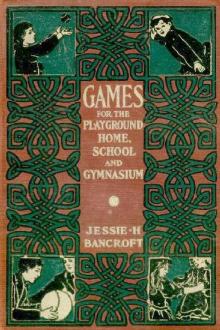Games for the Playground, Home, School and Gymnasium by Jessie Hubbell Bancroft (top novels of all time .txt) 📕

- Author: Jessie Hubbell Bancroft
- Performer: -
Book online «Games for the Playground, Home, School and Gymnasium by Jessie Hubbell Bancroft (top novels of all time .txt) 📕». Author Jessie Hubbell Bancroft
A ball caught on the center base is, of course, a return ball from the corner to which a predecessor threw it, and must be a fair throw, whether sent by one of the opponents' guards or his own goal keeper.
It may make clearer the rotation of the play to illustrate as follows: The game opens with Number One ready on the center base belonging to his team. His group of guards, that is, those bearing the odd numbers, are guarding the corner behind him on the right-hand side of the field. He therefore throws the ball on the referee's signal to the corner goal keeper for his team at the opposite end of the ground on the right-hand side. Immediately that he has thrown the ball, he steps back among his group of guards bearing the odd numbers, and Number Two of his team, who belongs to the group of guards on the left-hand side of the field, steps forward at once to the center base. Meanwhile, the ball may have been caught by the goal keeper to whom it was thrown, or by one of the guards surrounding him. It is at once tossed back to the center base from which it came, and Number Two guard should be there to catch it.
Number Two then throws the ball to the goal keeper for his team on the left-hand side of the ground. Whoever catches it at once throws it back to the same throwing base, and Number Three should be there to receive it, Number Two having returned to the ranks of his guards. So the game goes on, the guards each taking a turn at the throwing base, and each throwing the ball to the corner goal keeper on his side of the field.
Meanwhile, the same sort of game is being played by the opposite team, two balls being in play at once, and each guard taking part in each game for each team, according as he is guard around an opponent's corner goal or a thrower from the center base to his own goal men.
Each goal keeper and thrower must keep one foot in his goal or base. It is thus permissible for a goal keeper to step out of his goal with one foot, or lean far out of the goal to catch the ball. Of course the best kind of a throw to a goal keeper is a high curved ball that will go over the heads of the guards and fall within his goal. No guard may step within the goal he guards.
Violation of the rules about overstepping territory constitutes a foul, and scores for the opposing team.
Very alert and rapid play is needed to make this game a success. As one team (Blues) may play faster than the other (Reds), it is not necessary that Number Six of the Red team and Number Six of the Blue team, for example, should be on the center throwing bases at the same time. The two games go on independently of each other.
FOULS.—The overstepping of boundaries in ways not allowed by the rules score one for the opponents.
SCORE.—A goal keeper scores one point for his team every time that he catches a ball which has not been touched by one of the guards around his goal. A ball caught by a goal keeper after being touched by a guard does not score.
In addition to the score made by goal keepers, a guards' score is kept, each player counting the number of balls he catches and holds, no matter where he be standing, whether in his position as guard or in the center base from which he is to be thrower. Such a catch by a guard scores one point, the guards reporting their points at the end of the game. Touching the ball does not score under any circumstances. It must be caught and held.
Fouls score for opponents, as stated under "Fouls."
The score for the game for either side is the sum of all of the balls caught, according to the above rules, by the goal keepers and guards on that side. The game is usually played on time limits of from twenty to forty minutes.
For experienced players, scoring by guards may be omitted if desired. The particular object of this feature is to encourage guards to expert work in catching the ball, instead of merely interfering.
DOUBLE DODGEBALL10 to 30 players.
Playground; gymnasium.
Basket ball; volley ball.
This is one of the most interesting games for players beginning to care for team work. The writer has known some boys to play the game persistently for several seasons in succession.
GROUND.—A court measuring from thirty to fifty feet in length by twenty to thirty in width is divided into two equal parts, forming two courts, each of which should be a little wider than it is long. A goal about two by four feet is marked in the center rear of each court, within the boundary lines. It facilitates the game if the end of each court may be a wall or fence, and thus make sort of a backstop behind the goal.
Each court has bases marked at even distances over its surface, wherein the different players stand. These may be marked simply as a cross for a footmark, or a small circle or square. There is no particular arrangement for these, the only object being to scatter the players, no mass play being allowed in the game.
PLAYERS.—The players, of no stipulated number, are divided into two equal teams. Each team appoints a captain, who stands at the middle of the dividing line and is responsible for the discipline of his team; a goal guard, whose duty it is to keep the ball from the goal and who stands in the goal; and from six to twelve players, each assigned a certain spot marked as his territory and from which he may not move more than two feet.
OBJECT OF GAME.—The object of the game is to throw the ball into the opponents' goal.
START.—The ball is put in play by being placed on the ground at the center of the dividing line between the two captains. At a signal from an umpire, each captain hits the ball with his fist. The ball is thereafter kept moving rapidly back and forth from one court to the other, hit always with the fist. After being caught or otherwise stopped, it should be bounced or thrown from one hand and hit with the fist.
RULES.—No player may move more than two feet from the base assigned him. At no time may players do mass work. Whenever a goal is made, the ball is again started from the center by the two captains. The goal guard may not step out of the goal, even with one foot. The ball must always be hit with the closed fist.
FOULS.—It is a foul to kick the ball; to hold it; to throw it with both hands or in any way except by batting with the closed fist; it is a foul to cross the dividing line. Each foul scores one point for the opposing team.
SCORE.—Whenever a ball touches the ground inside of a goal, it scores two for the batting side. Fouls count for the opposing side, as above stated. The game is played in three rounds of fifteen minutes each, with a rest of five minutes between. The teams change courts for successive rounds. The team wins which has the highest score at the end of the third round.
6 to 30 or more players.
Playground; gymnasium; parlor.
Volley ball; basket ball; gas ball.
This game is very similar to Volley Ball, but differs from that game in the fact that the ball is hit with the fist instead of the open hand; that the ball may bound on the ground; and that the general rules are simpler. For large numbers two balls may be used, as described at the end.
GROUND.—The ground should be, if possible, one hundred feet long and sixty feet wide, with clearly defined boundaries. Across the center of the ground a rope or cord is stretched, head high, which divides the ground into two equal courts. If desired, each court may be divided into small squares, one for each player, to prevent mass play.
PLAYERS.—The players are divided into two equal teams, each of which scatters promiscuously over the court unless assigned to squares as described above. The players in each team should be numbered consecutively to facilitate rotation in serving. One officer will be needed to act as umpire and scorer.
OBJECT OF GAME.—The object of the game is to send the ball back and forth across the stretched cord, striking it only with the fist. The game is defensive; that is, the scoring is done by one party when the opponents fail to return the ball or to keep it properly in play.
START.—The ball is put in play by a regular serve at the opening of the game, after each point scored, and after going out of play. The players take turns in serving for their team, being numbered before the game opens. The sides alternate in serving after a score.
The player who serves the ball should stand at a central point ten feet from the dividing line, and may serve the ball in two ways. He may bound it and bat it with the fist over into the opponents' court, or he may hold it above his head, let go of it, and as it falls serve it with his fist. The ball must go over the line to be in play. Should a server fail in this, the ball must be handed to the opposite side, which then has a trial. After a ball has otherwise gone out of play, it is served anew by the side responsible for the failure.
RULES AND POINTS OF PLAY.—The ball must cross into the opponents' court above the cord to score or be properly in play.
A ball to score its highest (two points) must be returned after a serve without bounding, although any number of players may hit it or keep it in the air before sending it back over the line. A ball may bound once before being returned and score less (one point). It is out of play if it bounds twice without being hit between the bounds.
Several methods of play are permissible, but the rule is invariable that the ball must always be hit with the closed fist, and always from underneath, except for sending it across the line. It must reach the opponents' court from a blow and not from a bound. Either fist may be used in striking a ball, but never both at once. A player may "dribble" the ball in the air before batting it over the line to the opponents; that is, he may keep it in the air by hitting it from underneath with his closed fist ("nursing" it) until he is prepared to bat it with his fist. A ball hit with the forearm is considered properly in play except for a service. Several players on one side may play on the ball before sending it into the opponents' court. In doing this the ball may bounce once after every time it is hit with the





Comments (0)